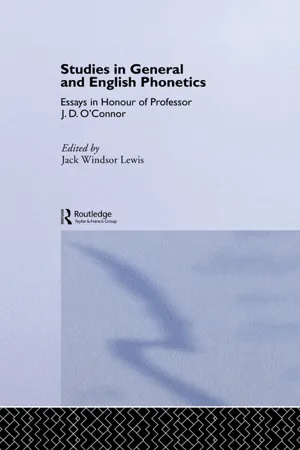Languages & Linguistics
Phonetic Assimilation
Phonetic assimilation refers to the process in which a sound becomes more like a neighboring sound in a word. This can occur when a sound is influenced by the characteristics of a nearby sound, such as becoming voiced or voiceless. Phonetic assimilation is a common phenomenon in many languages and can affect the pronunciation of words.
Written by Perlego with AI-assistance
6 Key excerpts on "Phonetic Assimilation"
- Silvia Luraghi, Vit Bubenik, Silvia Luraghi, Vit Bubenik(Authors)
- 2013(Publication Date)
- Bloomsbury Academic(Publisher)
This survey begins with assimilation and traditional efforts to explain it by appeal to ‘ease of articulation’ (section 2). Section 3 outlines a ‘preference’oriented approach to changes associated with syllable structure. Section 4 addresses final devoicing and efforts to anchor it in Universal Grammar (UG). Section 5 discusses metathesis and dissimilation, often irregular patterns of change, in light of recent work giving the listener a central place in sound change. Section 6 turns to vocalic chain shifts in the context of the study of sound change in progress. Section 7 treats the overarching issue of a possible ‘life-cycle of sound change,’ and section 8 concludes.2. Assimilation and Ease of ArticulationAssimilation is a prototypical sound change. As the name suggests, it covers processes whereby segments become more alike, processes which are commonplace in both synchronic alternations and historical change.Consider the sharing of laryngeal features within obstruent clusters.5 In Indo-European, a *-t suffix triggered a laryngeal assimilation of the final stop in the root *négw - ‘become dark’ yielding Indo-European *nékw t-, ancestor of night . Voiced *gw takes on the voicelessness of *t, a process which created many daughter-language alternations.6 This pattern and many others—like assimilation of /n/ to the place of following obstruents with /in+/ of i m possible —represent partial assimilation, where segments come to share some feature(s) but remain distinct. Total assimilation can be illustrated with similar changes within Indo-European: In Italian notte ‘night,’ the old cluster has yielded a single long stop. Or, for instance, Sihler (1995: 207) gives this history of the Attic form for ‘eye’: omma (ὂµµα) < *opma < *okw ma.In the above examples, assimilation is regressive, from right to left, but progressive assimilation is also well-attested. Historically, Germanic languages had /x/ with a relatively unrestricted distribution, including codas (cf. Robinson 2001). Some modern German dialects, like Alemannic, retain the original velar fricative pronunciation [x] in codas regardless of the preceding segment. In most varieties of German, though, a progressive assimilatory process arose so that after front vowels, the fricative is realized as palatal [ç].7The examples above reflect contact (‘adjacent’) assimilation. ‘Distant’ assimilation is common with laryngeal and manner but not place features in consonant harmony (Rose and Walker 2004). Distant place assimilations are, though, widespread with vowels, such as Germanic umlaut. These vowel-to-vowel assimilations take place over intervening consonants and perhaps syllables. For example, Old High German formed adverbs in -o from adjectives, including forms in –i . In the latter case, back stem vowels like /o:/ took on the frontness of following i (or j- eBook - ePub
Linguistics for Language Teachers
Lessons for Classroom Practice
- Sunny Park-Johnson, Sarah J. Shin(Authors)
- 2020(Publication Date)
- Routledge(Publisher)
assimilation causes a sound to become more like a neighboring sound in terms of one or more of its phonetic characteristics. Assimilation occurs mainly for ease of articulation; that is, assimilation makes it easier to move the articulators to produce different sounds consecutively in fluent speech.In Table 3.2 , we saw that [r], a typically voiced sound, became voiceless after voiceless consonants, [k] and [f], in fast speech. This process is called devoicing. Liquids and glides after voiceless consonants in English words such as play [pl̥ɛɪ], prod [pr̥ad], and cure [kj̥ur] are often devoiced. Devoicing is a kind of assimilation because the lack of voicing in the [p] and [k] sounds spreads to [l], [r], and [j], making these normally voiced sounds voiceless. Speaking in terms of articulatory phonetics, devoicing happens because the vocal folds do not start vibrating immediately after the release of the voiceless consonant closure.Table 3.3 [m] and [θ] Described in Terms of Voicing, Place, and MannerVoicing Place Manner [m] Voiced Bilabial Nasal [θ] Voiceless Interdental Fricative Table 3.4 [m], [p], and [θ] Described in Terms of Voicing, Place, and MannerVoicing Place Manner [m] Voiced Bilabial Nasal [p] Voiceless Bilabial Stop [θ] Voiceless Interdental Fricative Voices From the Classroom 3.2—Teaching the Different Pronunciations of the -ed Ending
When teaching past tense, I use phonology to teach the different pronunciations of the -ed ending. For this lesson, I explain the difference between voiced and voiceless sounds, asking students to touch their throats as we go through different sounds together so they can feel their vocal cords vibrating or not. Then, in groups, they receive a stack of cards, each with three words with -ed on them (for example, one card might have asked, filled, and wanted - eBook - ePub
Studies in General and English Phonetics
Essays in Honour of Professor J.D. O'Connor
- Jack Windsor Lewis(Author)
- 2012(Publication Date)
- Routledge(Publisher)
It may lead observers of loanword pronunciations to investigate and judge how far certain realisations of speech sounds can still be said to fall within the English phoneme areas. Given the fact that the phoneme areas of two languages will often overlap considerably, and that phonological adaptation of the foreign sounds is to be expected, this is looking at the facts through the wrong end of the telescope. What should be done instead is to judge whether the sounds used by the speaker of the receiving language fit within the phoneme areas of his-her own variety of native speech. TRANSPHONEMISATION AND THE UNITS OF ADAPTATION The pronunciation form of English loanwords in the receiving language normally establishes itself as the result of a process of ‘transphonemisation’ (Filipović 1960: 12). This means that every English phoneme is replaced by what is felt to be its native counterpart. Such substitutions are made on quite regular lines: the great majority of the counterparts are entirely self-evident, though in certain cases different choices may be open to the speaker. A contrastive analysis of the two sound systems involved will of course throw some light on the substitutions that take place. A thorough and fairly lengthy contrastive analysis, indeed, often precedes the discussion of substitutions made. 2 Two cautionary remarks are in place here: first of all, a great deal of the differential detail that is thrown up turns out to be irrelevant to the transphonemisation process: second, the phonemic systems that are being compared may well have been constructed on such rigorously economic lines that certain quite normally functioning equivalences are missed. It is more fruitful, therefore, to take cognisance of the adaptation features with a mind free from preconceptions induced by a formal contrastive analysis - eBook - ePub
- Kristin Denham, Anne Lobeck(Authors)
- 2018(Publication Date)
- Routledge(Publisher)
turtur. But the second one changed to /l/ to make the words more dissimilar.Sometimes sounds exchange places, known as metathesis. For example, ask can be pronounced with the /s/ and /k/ exchanging places, as was the case in Old English, and still is for many speakers. This exchange happens also with the word asterisk, which can be pronounced with the final two sounds switched: asteriks. And bird used to be brid; wasp used to be waps. Or consider the mismatch between the spelling of iron and its common pronunciation, which involves switching—metasthesizing—the vowel and the /ɹ/; it’s not i-ron but i-orn.Sometimes phonological rules involve insertion of a sound, as when a word like realtor has an vowel added between the /l/ and the /t/, resulting in a pronunciation like real-a-tor. Other times, there is deletion of a sound. Consider a word like fifths /fɪfθs/ or sixths /sɪksθs/ in which three fricatives occur in a row. One or even two of them is typically deleted in casual speech, so the pronunciation is actually /fɪfs/ or /fɪθs/ or even /fɪs/. Or consider the compound word tennis shoes, which is rarely pronounced with the /s/ at the end of tennis—that /s/ is deleted.Importantly, all of these phonological processes for all speakers are always patterned and systematic, never random; they are rules of each language or dialect.Auditory phoneticsAcoustic phonetics is the study of the physical production of sounds, in terms of frequency, pitch, duration, and other factors, as discussed above. Auditory phonetics is the study of how sounds are perceived by the human ear or recognized and processed by the human brain. Linguists might investigate how such phrases like I scream and ice cream are distinct phonetically and conduct experiments to better understand how they are processed similarly and differently. (Or compare that’s tough versus that stuff, mice eat versus my seat.) How and why do we “mishear” song lyrics, for example, and what sorts of factors—including context—might affect that? Is it this guy or the sky - eBook - ePub
Second Language Learning and Language Teaching
Fifth Edition
- Vivian Cook(Author)
- 2016(Publication Date)
- Routledge(Publisher)
Presystemic. At this stage learners learn the sounds in individual words but without any overall pattern, i.e. they may learn the /əυ/ in ‘no’ but not the /əυ/ in ‘coat’.- 2 Transfer. Now the learners start to treat the second language sounds systematically as equivalent to the sounds of their first language, i.e. they see the second language sounds through the lens of the first.
- 3 Approximative. Finally the learners realise their native sounds are not good enough and attempt to restructure the L2 sounds in a new system; they realise that the sounds are not just variants of their native sounds.
This example shows the important role of transfer from one language to another in acquiring pronunciation. It is not, however, a matter of just transferring a single phoneme from the first language to the second but of carrying over general properties of the first language. The phonemes of the language do not exist as individual items but are part of a whole system of contrasts. Practising a single phoneme or pair of phonemes may not tackle the underlying issue. Though some of the learners’ pronunciation rules are related to their first language, they nevertheless still make up a unique temporary system—an interlanguage.Learning below the Phoneme Level
For many purposes the phoneme cannot give the whole picture of pronunciation. As well as the allophone mentioned above, the elements which make up a phoneme also need to be taken into account. Seemingly different phonemes share common features which will present a learning problem that stretches across several phonemes.Let us take the example of voice onset time (VOT), which has been extensively researched in SLA research. One of the differences between pairs of plosive consonants such as /t~d/ and /k~g/ is the VOT—the interval of time between the consonant and the following vowel. The voicing of the vowel can start more or less at the same moment as the release of the obstruction by the tongue or the lips; this will then sound like a voiced /b/ ‘boss’ or /g/ ‘go’. Or voicing can start a few milliseconds after the release of the plosive, yielding voiceless /p/ ‘pod’, /k/ ‘cod’. The difference between voiced and voiceless plosives is not a matter of whether voicing occurs but when it occurs, i.e. of timing relative to the moment of release. The distinction between voiced and voiceless plosives is a matter of convention rather than absolute. Hence it varies from one language to another: the Spanish /k~g/ contrast is not exactly the same as the English /k~g/ because English /k/ has VOT that starts at +80 milliseconds but Spanish /k/ has VOT of only +29 mills, almost overlapping with the English /ɡ/. This is shown in Figure 4.2 - eBook - ePub
- Robert McColl Millar, R L Trask(Authors)
- 2015(Publication Date)
- Routledge(Publisher)
umlaut by specialists in Germanic. As far as possible, I’ll try to avoid using such additional terms.The opposite of assimilation is dissimilation: making sounds more different than they were before. Given what I have said about the naturalness of assimilation, you might wonder why dissimilation should ever occur at all. The explanation lies in what we might call the ‘tongue-twister effect’. One reason why a tongue-twister is hard to say is that our speech organs can get weary of making the same sound (or very similar sounds) repeatedly. This effect occasionally shows up in ordinary speech. For example, the Latin word arbor ‘tree’ has become árbol in Spanish (another modern form of Latin), in which the second of the two occurrences of [r] has been dissimilated to an [1]. On the other hand, Italian colonello ‘colonel’ appears in Spanish as coronelo: this time the first of the two occurrences of [1] has been dissimilated to [r]. (Note that English, bizarrely (but perhaps typically), uses the Italian-type spelling but the Spanish-type pronunciation.)This kind of phenomenon regularly crosses greater linguistic barriers. For instance, the ancestor of Modern German Herberge, ‘hostelry’, most readily known by most of us through Jugendherberge ‘Youth Hostel’, was borrowed into a number of Romance languages as a word for ‘inn’. In Italian, for instance, the word occurs as Albergo. It would, I imagine, need an historical linguist to see the connection. Like all the Romance languages, Italian has gone through periods where [h] has been lost entirely; unlike some of its sisters, however, [h] has not ‘returned’ through borrowing or internal sound development. We can also see that the initial [r] has been altered to [l], while the second has been maintained, possibly as a form of dissimilation. The same thing happened in French. The problem is that the modern outcome of these changes – Auberge – has gone through an extra stage where the initial [l] – originally [r] – has been vocalized
Index pages curate the most relevant extracts from our library of academic textbooks. They’ve been created using an in-house natural language model (NLM), each adding context and meaning to key research topics.
Explore more topic indexes
Explore more topic indexes
1 of 6
Explore more topic indexes
1 of 4





